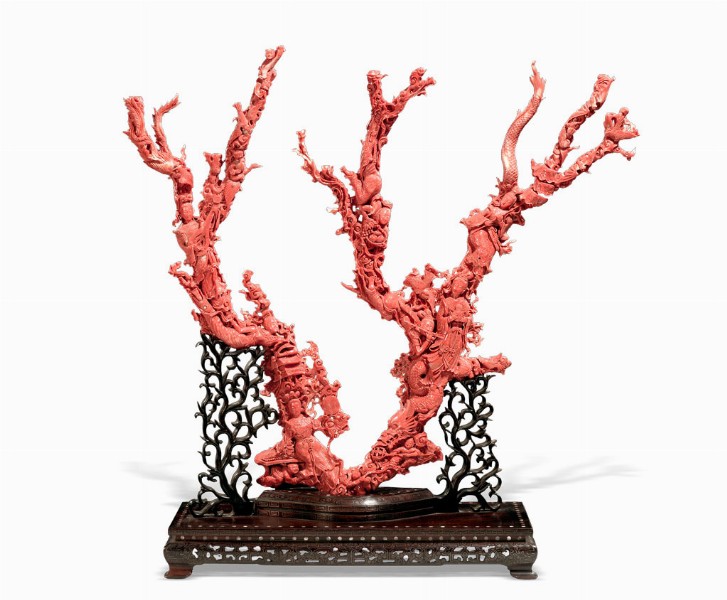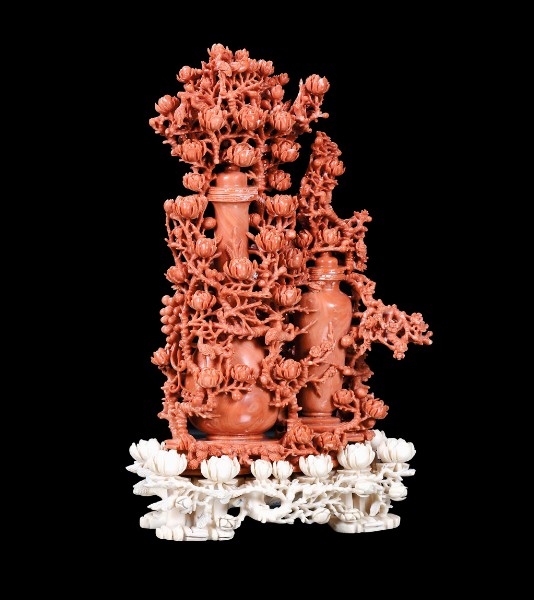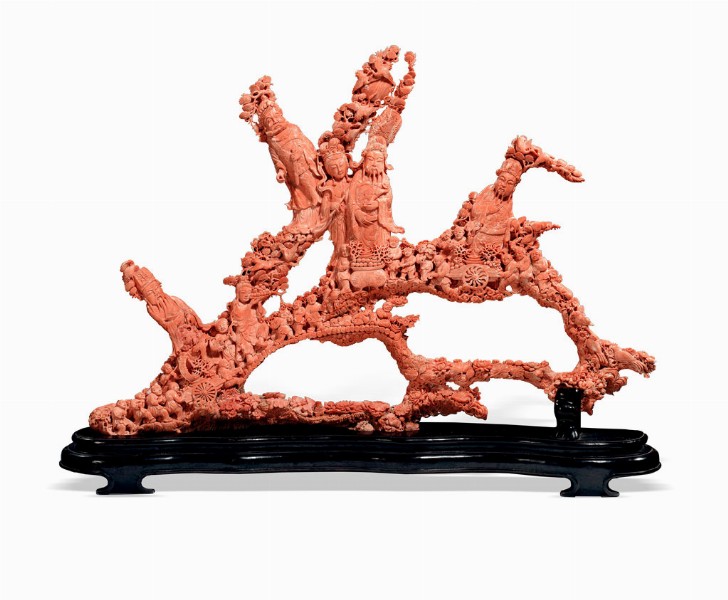Bianca Dolfin
Centuries-old beliefs on coral, linked to its metamorphic nature, identify it as an expression of the balance between life and death, able to embrace changes and exalt them. As talisman or harbinger of fortune, with alleged healing and apotropaic properties, symbol of longevity and strictly connected to regeneration cycles, thanks to its blood-red colour and to its nature hanging in the balance among animal, plant and mineral kingdom. Coral has been the subject of numerous myths and legends. The Hellenic world connects the origin of coral to the myth of Perseus, who – as told by Ovid in his Metamorphoses – washed in the sea the blood coming from Medusa’s head and the contact between her blood and the sea created these petrified sea branches. In the East, mainly the Mongolian, Tibetan and Nepalese cultures ascribe to this precious material magical and healing properties, while in China, its intense red colour made it a symbol of happiness and richness. Coral manufacturing started in the prehistoric period and the first large Mediterranean civilizations used it to create artifacts or to decorate objects. But it was with the Romans that coral became a purely ornamental element, used to decorate many pieces of jewellery. The “red gold” fascinated also the East and, during the Medieval period, it was fished in our seas to create amulets to be exported in the far Asian lands. At the beginning of the 16th century, Trapani and Genoa became the main centres for the artistic manufacturing of coral that, in addition to religious objects, as for example rosaries, was used to create jewels and sculptures. At the end of the 19th century, then, the Italian pre-eminence passed on to Naples, or more precisely to Torre del Greco, which used the coral deposits found in Sciacca, while in the East it was fished in Japan and in the Pacific Ocean. Because of its beauty, of the difficulties in its fishing and of the legends connected to its powers, coral has always been expensive; in order to be good, it has to be compact, without holes or damages and with a uniform colour. Chinese coral manufacturing is proven especially between the end of the 19th century and the 20th century; previous artifacts are extremely rare and the production was concentrated mainly in the southern areas of the country and in Taiwan. The value of these sculptures is determined by the dimension and weight of the coral itself – the biggest the dimensions the oldest the coral –, by the intensity and the homogeneity of the colour in addition to the perfection of the object and the carving. Differently from the Mediterranean artists and workshops, Chinese artists are anonymous, linked more to a manufacturing skill than to an artistic value. According to Oriental buyers, the presence of an original base increases the value of the objects, especially if the base is made of ivory for the incredible chromatic contrast they create.
Centuries-old beliefs on coral, linked to its metamorphic nature, identify it as an expression of the balance between life and death, able to embrace changes and exalt them. As talisman or harbinger of fortune, with alleged healing and apotropaic properties, symbol of longevity and strictly connected to regeneration cycles, thanks to its blood-red colour and to its nature hanging in the balance among animal, plant and mineral kingdom. Coral has been the subject of numerous myths and legends. The Hellenic world connects the origin of coral to the myth of Perseus, who – as told by Ovid in his Metamorphoses – washed in the sea the blood coming from Medusa’s head and the contact between her blood and the sea created these petrified sea branches. In the East, mainly the Mongolian, Tibetan and Nepalese cultures ascribe to this precious material magical and healing properties, while in China, its intense red colour made it a symbol of happiness and richness. Coral manufacturing started in the prehistoric period and the first large Mediterranean civilizations used it to create artifacts or to decorate objects. But it was with the Romans that coral became a purely ornamental element, used to decorate many pieces of jewellery. The “red gold” fascinated also the East and, during the Medieval period, it was fished in our seas to create amulets to be exported in the far Asian lands. At the beginning of the 16th century, Trapani and Genoa became the main centres for the artistic manufacturing of coral that, in addition to religious objects, as for example rosaries, was used to create jewels and sculptures. At the end of the 19th century, then, the Italian pre-eminence passed on to Naples, or more precisely to Torre del Greco, which used the coral deposits found in Sciacca, while in the East it was fished in Japan and in the Pacific Ocean. Because of its beauty, of the difficulties in its fishing and of the legends connected to its powers, coral has always been expensive; in order to be good, it has to be compact, without holes or damages and with a uniform colour. Chinese coral manufacturing is proven especially between the end of the 19th century and the 20th century; previous artifacts are extremely rare and the production was concentrated mainly in the southern areas of the country and in Taiwan. The value of these sculptures is determined by the dimension and weight of the coral itself – the biggest the dimensions the oldest the coral –, by the intensity and the homogeneity of the colour in addition to the perfection of the object and the carving. Differently from the Mediterranean artists and workshops, Chinese artists are anonymous, linked more to a manufacturing skill than to an artistic value. According to Oriental buyers, the presence of an original base increases the value of the objects, especially if the base is made of ivory for the incredible chromatic contrast they create.


